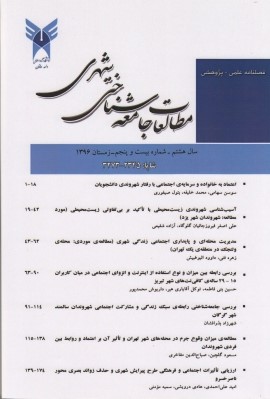بررسی رابطه بین برنامهریزی توسعه محلهای و کیفیت زندگی در شهر مهریز
محورهای موضوعی : مطالعات جامعه شناختی شهریسید علیرضا افشانی 1 * , نعیمه احمدی بغداد آبادی 2
1 - دانشیار جامعه شناسی دانشگاه یزد
2 - دانشجوی کارشناسی ارشد جامعه شناسی دانشگاه یزد
کلید واژه:
چکیده مقاله :
هر کشوری برای رسیدن به توسعه باید برای ارتقای زندگی ساکنانش برنامهریزی نماید. یکی از زمینههایی که میتوان در برنامهریزیها به آن توجه نمود محلات است. هدف پژوهش حاضر بررسی رابطه ی برنامهریزی توسعه محله ای و کیفیت زندگی در بین شهروندان است که برای رسیدن به اهداف پژوهش از تلفیق نظریه ی کنش متقابل نمادین وکارکردگرایی ساختاری استفاده شده است. روش مورد استفاده در این تحقیق از نوع پیمایشی است، دادهها با ابزار پرسشنامه و با استفاده از شیوه ی نمونهگیری خوشهای چندمرحلهای از 385 نفر از شهروندان ساکن در شهر مهریز گردآوری شده است. اعتبار ابزار به روش اعتبار محتوا و برای سنجش پایایی از ضریب آلفای کرونباخ استفاده شد. دادهها به کمک نرمافزارهای SPSS و AMOS تحلیل شدند. یافتههای تحقیق گویای آن است که بین میزان برنامهریزی توسعه ی محلهای و کیفیت زندگی و ابعاد آن رابطه ی مستقیم و معناداری وجود داشت. مدل معادله ی ساختاری نشان داد متغیر برنامهریزی توسعه ی محلهای 24 درصد از واریانس متغیر کیفیت زندگی را تبیین می کند و شاخصهای برازش نیز نشانگر مطلوبیت مدل بود.
Each country needs to plan for the development of its inhabitants. One of the areas that can be considered in Planning is neighborhood. The purpose of this study was to investigate the relationship between community development planning and quality of life among citizens. Symbolic interaction theory and structural functionalism were utilized to form the theoretical framework of the study. The method used in this research was of survey type. Data was collected using a questionnaire and, using a multi-stage cluster sampling method, 385 citizens living in Mehriz city were selected as the sample. Validity of the tool was determined by content validity method and Cronbach's alpha coefficient was used to assess the reliability of the questions. Data were analyzed using SPSS and AMOS software. The findings of the research indicated that there was a direct and significant relationship between the level of community development planning and quality of life and its different dimensions. Structural equation modelling showed that the variance of community development planning explained 24% of the variance of quality of life and fit indices also indicated the utility of the model.

